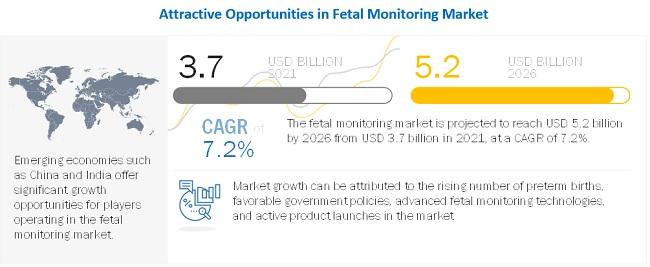The fetal monitoring market is projected to reach USD 5.2 billion by 2026 from USD 3.7 billion in 2021, at a CAGR of 7.2% from 2021 to 2026. The development of noninvasive, portable, and advanced fetal monitors and emerging markets and strengthening infrastructure are expected to offer growth opportunities in the market during the forecast period.
The coronavirus pandemic has compelled regulatory bodies, such as the FDA, to ease their regulatory norms for fetal monitors to support the uninterrupted care regime of expectant mothers. Relaxations in rules have paved the way for several key players to smoothly launch fetal monitors equipped with tele-ultrasound monitoring, noninvasive features, and portable technologies.
The outbreak of COVID-19 has led to various valuable partnerships among companies, which is anticipated to fuel the market's growth. For instance, in January 2021, Israel-based Nuvo Group (offering a remote pregnancy monitoring platform) entered into a commercial agreement with Axia Women’s Health, an innovative women’s health network.
𝐆𝐞𝐭 𝐌𝐨𝐫𝐞 𝐈𝐧𝐬𝐢𝐠𝐡𝐭𝐬, 𝐆𝐫𝐚𝐛 𝐏𝐃𝐅 @ https://www.marketsandmarkets.com/pdfdownloadNew.asp?id=35700261
The fetal monitoring market is expanding with the latest innovative technologies, backed by escalating research and product launches. Fetal monitoring technologies are now being streamlined to provide greater assistance in utero fetal surgeries, consisting of challenging physical fetal access and technological complications.

Research and technological advancements in fetal monitoring systems have increased focus on noninvasive monitoring procedures. Obstetrics has been introduced with noninvasive diagnosis technologies such as Doppler studies, cell-free fetal DNA assessment, electronic fetal monitoring (EFM), and fetal acid-base status. Fetal and neonatal assessments are carried out during antepartum via percutaneous umbilical cord blood sampling and during intrapartum with fetal scalp blood sampling immediately after birth.
Fetal phonocardiography has been integrated with advanced data acquisition systems and databases. Progressing data analytics, synthetic data generation by advanced mathematical models, and classifications & processing algorithms are under active research & development to increase fetal motoring data processing efficacy.
For More Info, Get Free Sample Pages @ https://www.marketsandmarkets.com/requestsampleNew.asp?id=35700261
The probes used in the Doppler technology (for example, the Philips Doppler transducer) range from USD 4,500 to USD 17,000. The SonoScape system from GE Healthcare costs around USD 9,000. These machines also incur maintenance charges, which amount to 15% of the unit's purchasing cost. The high costs of fetal monitoring equipment can be challenging to low-income nations and low-resource hospitals, thus restraining this market's growth.
The fetal monitoring market is segmented into ultrasound devices, electronic maternal/fetal monitors, fetal electrodes, fetal doppler devices, uterine contraction monitors, telemetry devices, accessories & consumables, and other products. Ultrasound devices are the largest segment in this market. This segment's growth can primarily be attributed to technological advancements, increasing congenital anomalies, maternal mortality, and rising regulatory approvals.
